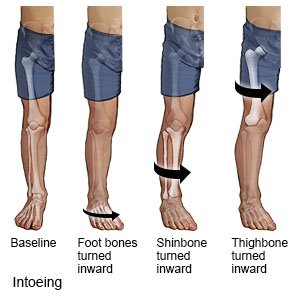Intoeing
Medically reviewed by Drugs.com. Last updated on Aug 4, 2025.
AMBULATORY CARE:
Intoeing
means your child walks with his or her toes pointed in. It is also called pigeon toe. One or both of your child's feet may be affected. Your child may start to show signs of intoeing any time up to about 8 years of age. Intoeing is common in children. It can be mild or severe and often goes away without treatment.
 |
Common signs of intoeing:
- A deep crease in your infant's foot that is rigid or hard to straighten, and a sharply curved outer foot
- Feet that turn inward when your child walks or runs
- A knee that points inward, and a turned in hip
- Bowed legs
- A big toe that points away from the toe next to it
- Sitting with bottom and thighs on the floor, knees bent, and feet behind (the legs form a W)
- Problems walking, such as tripping often
Contact your child's healthcare provider if:
- Your child develops a limp when he or she walks.
- Your child has leg pain or swelling.
- You have questions or concerns about your child's condition or care.
Treatment
may be needed treatment if the foot position does not straighten on its own. Treatment may also be needed if your child's intoeing is caused by a problem such as cerebral palsy or clubfoot. Most intoeing treatment is meant for babies who have not started to walk. Your child's healthcare provider can tell you if your toddler or older child needs treatment.
- Stretches may help your infant's foot straighten. Your child's healthcare provider will tell you if stretches might help. They do not work for every infant. If the stretches are recommended, the provider will show you how to do them.
- Casts or braces may be used to help move your child's feet to the correct position. A healthcare provider will apply a cast or brace and leave it in place for a time. It will then be removed and the foot will be moved closer to the correct position. Then a new cast or brace will be applied. This will continue for up to 6 months. Your child's provider may wait until your child is 4 to 6 months old before starting. This is to make sure the intoeing is not going to go away on its own. The goal is to have the intoeing corrected before your child starts walking.
- Surgery is only used for severe forms of intoeing that are not corrected with other treatment. Healthcare providers wait until the child is 9 or 10 years old to do surgery, to be sure it is necessary.
Manage your child's intoeing:
- Do not use any corrective devices unless directed. Shoe inserts and cables do not help fix the problem. They can also make it hard for your child to play and walk.
- Ask about your child's activities. Ask if your older child can do activities such as sports. He or she may need to wait if intoeing causes him or her to trip.
Follow up with your child's healthcare provider as directed:
Your child may need more tests to see if the intoeing is getting better over time. Tests may also show if your child is developing new problems. Write down your questions so you remember to ask them during your visits.
© Copyright Merative 2025 Information is for End User's use only and may not be sold, redistributed or otherwise used for commercial purposes.
The above information is an educational aid only. It is not intended as medical advice for individual conditions or treatments. Talk to your doctor, nurse or pharmacist before following any medical regimen to see if it is safe and effective for you.
Further information
Always consult your healthcare provider to ensure the information displayed on this page applies to your personal circumstances.
